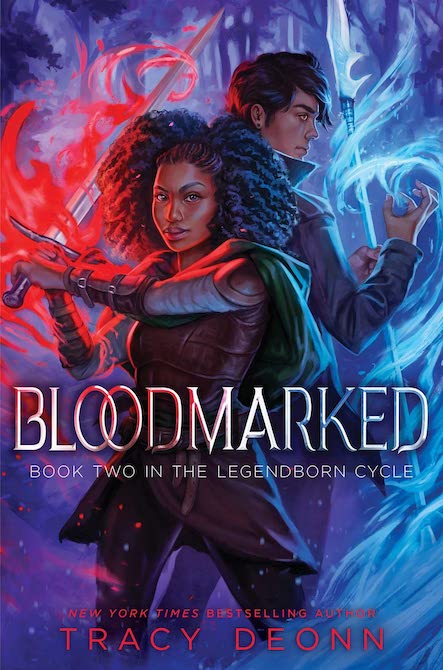When we last left Bree, she had come into a well of power, two wells technically. With access to both Root magic and King Arthur’s legendary abilities, Bree is about to step into the highest rank in the Legendborn Order. Or she would if the rich white people who have been controlling the organization for centuries would let her. They have their own sinister plans, both for the order and for Bree herself. And then there’s the matter of Nick and Selwyn. Nick is missing, having been absconded by his father. Sel, meanwhile, has run afoul of the Order and may be headed down the same demonic path as his mother. Bree and her team head out on the road, running from the Order and toward Nick, but something is hunting them along the way. A Hunter from King Arthur’s days is awake and seething, with its sights set on Bree.
Friends become enemies and enemies become friends. Power corrupts and power inspires. Secrets, lies, and betrayals abound, and Bree is stuck in the middle of it, seen by some as a weapon, others as a toy, and others still as a tool. But Bree is as she always has been: a young woman who has seen too much and still has a long way to go. The only way to survive this is to figure out who to trust, a task that is much harder than she anticipates.
The racial politics Tracy Deonn explores in Bloodmarked is just as visceral the second time around as it was the first. After the big twist at the end of Legendborn, I knew the white people running the Order were going to have some Big Feelings about having to literally bow down to a Black girl. As with the first book, most of the problems Bree faces come down to systemic racism and misogynoir, except in her case, that bigotry is also laced with deadly magic.
Buy the Book


Bloodmarked
Deonn also expands the worldbuilding for the rest of the hierarchy—particularly the regents, vassals, mageguard, Merlin forces, and lieges—not just for the internal politics but, for example, what it’s like to be a BIPOC underling who doesn’t have a blood lineage to fall back on. There’s a lovely moment about halfway through where Bree meets another Black woman in the Order and the two talk about their experiences navigating that treacherous space. Later, she meets her Black elders who are able to offer Bree guidance that can help her not just survive but thrive. I’ve been on all three sides of that conversation, as the young Black person, as the older person hugging my younger cousins and telling them they’ll get through it, and as the elder defending and educating the younger generations. These moments are crucial for Black teens to read and experience, and Deonn does an excellent job exploring each aspect. We see Bree lean on her elders and community while also learning how to stand on her own, how to incorporate what she’s been taught while recognizing she still has much to learn. This is brilliant, nuanced work we don’t see a lot of in YA fantasy.
This book in particular digs into the messiness of intergenerational responses to trauma and racial violence. Bree’s enslaved ancestors, the dead who lived during the Black Codes and Jim Crow, the living who watched their hard earned civil rights gradually be dismantled all over again, and Bree herself all have very different attitudes toward the Order and the Hunter. None of those reactions are wrong, but if you are aware of the historical context they were living in, you get why they behave the way they do. Vera’s choice had devastating ramifications for her descendants, but it’s one she would make again without hesitation. When intergenerational trauma confronts state-sanctioned violence, Vera’s rage and her descendants’ fear is understandable. This isn’t an issue of good versus evil, as the Legendborn Order likes to divide things, but of survival. It’s facing Scylla and Charybdis and making the least worst choice. It’s cutting off your foot to free yourself from the trap. It’s doing whatever it takes to get your heirs to adulthood in the face of a world that is designed to destroy them. Bree has the luxury of being able to fight the racist system, whereas Vera had to scrabble just to keep breathing. Vera’s choice may not have been fair or even right, but it was the only one she had.
As much as there is to love about Bloodmarked, there were a few aspects that didn’t work for me. For one, I’m not convinced the plot structure justifies the length. Although largely interesting, there is a lot of repetition in the plot—of conversations, battles, and betrayals—that probably didn’t do the structure any favors. For two, Sel and Nick. In the sequel, the boys are twice as complicated and thrice as brooding. They spend most of the book sulking, scowling, or moping. They make choices for Bree without her consent and then pout about it when she pushes back. If you aren’t a love triangle person, this may not be the series for you. I liked what Deonn did with the trope in the first book, but am far less enthused with it in the sequel. The boys are exactly what you expect from the trope and frankly Bree could do a whole lot better than either of them. I hope in the final book, Bree develops some standards for who she takes as a romantic partner, because neither Nick nor Selwyn come anywhere close to being worthy of her. Y’all may be fighting over Team Nick versus Team Sel, but I’m staunchly Team Bree Breaks Up With Both Of Them, Discovers She’s Bi, and Hooks Up With Alice.
My third issue is less about Bloodmarked specifically and more about YA fantasy as a whole. When I review YA, I try very hard to focus on who the target audience is rather than what I as a nearly 40-year-old adult want. That being said, I struggle with plots that hand teenagers ultimate power and then treat all adults trying to curb that power as evil. To be fair, there are very few not-evil adults in the Legendborn series. Yet if I was part of an ancient order where the person who decided my fate was going to be a 17-year-old who can’t decide which boy she wants to kiss, I’d have second thoughts. I wouldn’t be a racist asshat about it, but I would also not be comfortable doing nothing. Bree needs guidance and support. She needs elders who are willing to help her learn how to be a leader, not just a king. She needs regents who can run the order while she learns what she needs to. Unfortunately for her, no adult steps up to that responsibility. Her elders, on both the Legendborn and Root sides, want her to stand down instead of stand beside them. As an adult, I can see why so many of them want to tell Bree what to do, and as a former teenager, I totally understand why she prickles at their attempts at control. There’s a reason this trope is so popular in YA fantasy.
Tracy Deonn’s Bloodmarked is a striking sophomore novel. The action is more intense, the conspiracies more wide-reaching, and the love triangle even more love triangle-ier. While it may not be a perfect book, it is an excellent one. From rich worldbuilding to detailed character development to a powerful examination of racism and intergenerational trauma, it makes for a solid second entry in the Legendborn trilogy.
Bloodmarked is published by Simon & Schuster Books for Young Readers.
Read an excerpt here.
Alex Brown is a Hugo-nominated and Ignyte award-winning critic who writes about speculative fiction, librarianship, and Black history. Find them on twitter (@QueenOfRats), instagram (@bookjockeyalex), and their blog (bookjockeyalex.com).










